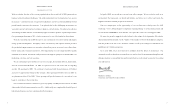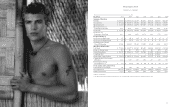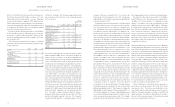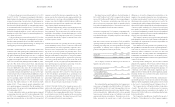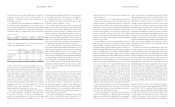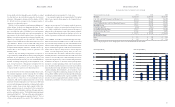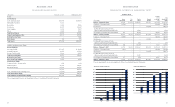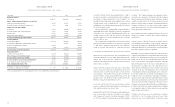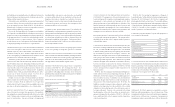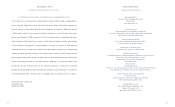Abercrombie & Fitch 2001 Annual Report Download - page 13
Download and view the complete annual report
Please find page 13 of the 2001 Abercrombie & Fitch annual report below. You can navigate through the pages in the report by either clicking on the pages listed below, or by using the keyword search tool below to find specific information within the annual report.
2524
Ab e rcro mbi e &Fitch
USE OF ESTIMATES IN THE PREPARATION OF FINANCIAL
S TAT E M E N T S The preparation of financial statements in con-
formity with generally accepted accounting principles requires
management to make estimates and assumptions that affect
the reported amounts of assets and liabilities as of the date of the
financial statements and the reported amounts of revenues and
expenses during the reporting period. Since actual results may
differ from those estimates, the Company revises its estimates and
assumptions as new information becomes available.
RECLASSIFICATIONS Certain amounts have been reclassified
to conform with current year presentation. The amounts reclas-
sified did not have an effect on the Company’s results of operations
or shareholders’ equity.
3. ISS U ANCES OF ACCOUNTING STA N DA R D S In June 2001, the
Financial Accounting Standards Board (“FA S B”) issued SFA S
No. 142, “Goodwill and Other Intangible Assets.” The standard
is effective starting with fiscal years beginning after December
15, 2001 (Fe b ru a ry 3, 2002 for the Company). SFAS No. 142
addresses how intangible assets that are acquired individually or
with a group of other assets should be accounted for in financial
statements upon their acquisition. It also addresses how goodwill
and other intangible assets should be accounted for after they
have been initially recognized in the financial statements.
Management anticipates that the adoption of SFAS No. 142 will
not have an impact on the Company’s results of operations or its
financial position.
S FAS No. 143, “Accounting for Asset Retirement Obligations,”
will be effective for fiscal years beginning after June 15, 2002
( Fe b ru a ry 2, 2003 for the Company). The standard requires enti-
ties to record the fair value of a liability for an asset retirement
obligation in the period in which it is a cost by increasing the car-
rying amount of the related long-lived asset. Over time, the
liability is accreted to its present value each period, and the cap-
italized cost is depreciated over the useful life of the related
obligation for its recorded amount or the entity incurs a gain or
loss upon settlement. Because costs associated with exiting
leased properties at the end of lease terms are minimal, man-
agement anticipates that the adoption of SFAS No. 143 will not
have a significant effect on the Company’s results of operations
or its financial position.
S FAS No.144, “Accounting for Impairment or Disposal of
Long-Lived Assets,” will be effective for fiscal years beginning aft e r
December 15, 2001 (February 3, 2002 for the Company), and
interim periods within those fiscal years. The standard addresses
financial accounting and reporting for the impairment or disposal
of long-lived assets. Management anticipates that the adoption
of SFAS No. 144 will not have an impact on the Company’ s
results of operations or its financial position.
4. PROPERTY AND EQUIPMENT Property and equipment, at
cost, consisted of (thousands):
2001 2000
Land $ 15,414 $ 14,007
Building 91,531 –
Furniture, fixtures and equipment 303,606 212,674
Beneficial leaseholds 7,349 7,349
Leasehold improvements 54,702 31,613
Construction in progress 28,721 118,553
Total $501,323 $384,196
Less: accumulated depreciation and amortization 136,211 105,411
Property and equipment, net $365,112 $278,785
5. LEASED FACILITIES AND COMMITMENTS Annual store
rent is comprised of a fixed minimum amount, plus contingent rent
based on a percentage of sales exceeding a stipulated amount. Store
lease terms generally require additional payments covering taxes,
common area costs and certain other expenses.
A summary of rent expense follows (thousands):
2001 2000 1999
Store rent:
Fixed minimum $83,608 $65,716 $51,086
Contingent 4,897 7,079 8,246
Total store rent $88,505 $72,795 $59,332
Buildings, equipment and other 1,566 2,777 2,574
Total rent expense $90,071 $75,572 $61,906
At Fe b ru a ry 2, 2002, the Company was committed to noncance-
lable leases with remaining terms of one to fourteen years. These
commitments include store leases with initial terms ranging pri-
marily from ten to fifteen years. A summary of minimum rent
commitments under noncancelable leases follows (thousands):
Ab e rcr o mbie&Fitch
and liabilities are recognized based on the difference between the
financial statement carrying amounts of existing assets and lia-
bilities and their respective tax bases.
Deferred tax assets and liabilities are measured using enacted
tax rates in effect in the years in which those temporary differ-
ences are expected to reverse. Under SFAS No. 109, the effect on
deferred taxes of a change in tax rates is recognized in income in
the period that includes the enactment date.
Prior to the Exchange Offer, the Company was included in
The Limited's consolidated federal and certain state income tax
groups for income tax reporting purposes and was responsible for
its proportionate share of income taxes calculated upon its fed-
eral taxable income at a current estimate of the Company’ s
annual effective tax rate. Subsequent to the Exchange Offer, the
Company began filing its tax returns on a separate basis.
SHAREHOLDERS’ EQUITY The Board of Directors declared a
two-for-one stock split on A&F’s Class A Common Stock, dis-
tributed on June 15, 1999 to shareholders of record at the close
of business on May 25, 1999. All share and per share amounts
in the accompanying consolidated financial statements for all
periods have been restated to reflect the stock split.
At February 2, 2002, there were 150 million shares of $.01 par
value Class A Common Stock authorized, of which 98.9 million
and 98.8 million shares were outstanding at Fe b ru a ry 2, 2002 and
Fe b ru a ry 3, 2001, respectively, and 106.4 million shares of $.01 par
value Class B Common Stock authorized, none of which were
outstanding at Fe b ru a ry 2, 2002 or Fe b ru a ry 3, 2001. In addition,
15 million shares of $.01 par value Preferred Stock were autho-
rized, none of which have been issued. See Note 13 for
information about Preferred Stock Purchase Rights.
Holders of Class A Common Stock generally have identical
rights to holders of Class B Common Stock, except that holders
of Class A Common Stock are entitled to one vote per share
while holders of Class B Common Stock are entitled to three votes
per share on all matters submitted to a vote of shareholders.
REVENUE RECOGNITION The Company recognizes retail
sales at the time the customer takes possession of the merchan-
dise and purchases are paid for, primarily with either cash or credit
card. Catalogue and e-commerce sales are recorded upon ship-
ment of merchandise. Amounts relating to shipping and
handling billed to customers in a sale transaction are classified
as revenue and the related costs are classified as cost of goods sold.
Employee discounts are classified as a reduction of revenue.
The Company reserves for sales returns through estimates based
on historical experience and various other assumptions that
management believes to be reasonable.
C ATALOGUE AND ADV E RTISING COSTS Costs related to the
A&F Quarterly, a catalogue/magazine, primarily consist of cata-
logue production and mailing costs and are expensed as incurred.
Advertising costs consist of in-store photographs and advertising
in selected national publications and are expensed when the
photographs or publications first appear. Catalogue and adver-
tising costs amounted to $30.7 million in 2001, $30.4 million in
2000 and $30.3 million in 1999.
STORE PREOPENING EXPENSES Preopening expenses related
to new store openings are charged to operations as incurred.
FAIR VA LUE OF FINANCIAL INSTRUMENTS The recorded
values of current assets and current liabilities, including receivables,
marketable securities and accounts payable, approximate fair
value due to the short maturity and because the average interest
rate approximates current market origination rates.
EARNINGS PER SHARE Net income per share is computed in
accordance with SFAS No. 128, “Earnings Per Share.” Net
income per basic share is computed based on the weighted aver-
age number of outstanding shares of common stock. Net income
per diluted share includes the weighted average effect of dilutive
stock options and restricted shares.
Weighted Average Shares Outstanding (thousands):
2001 2000 1999
Shares of common stock issued 103,300 103,300 103,300
Treasury shares (4,198) (3,239) (429)
Basic shares 99,102 100,061 102,871
Dilutive effect of options and
restricted shares 3,422 2,095 4,770
Diluted shares 102,524 102,156 107,641
Options to purchase 5,630,000, 9,100,000 and 5,600,000 shares of Class A Common
Stock were outstanding at year-end 2001, 2000 and 1999, respectively, but were not
included in the computation of net income per diluted share because the options’ exer-
cise prices were greater than the average market price of the underlying shares.



